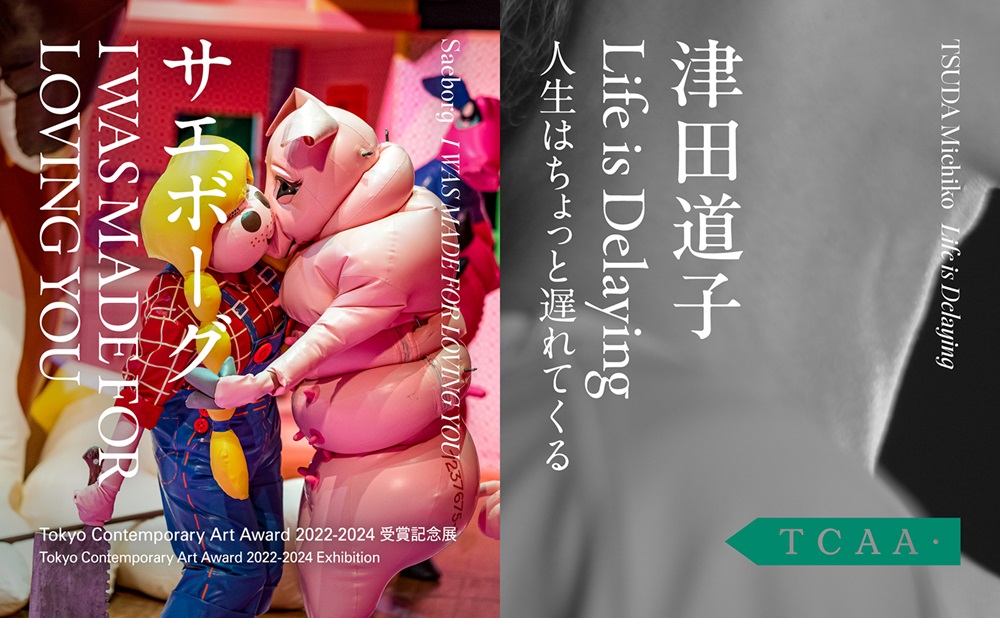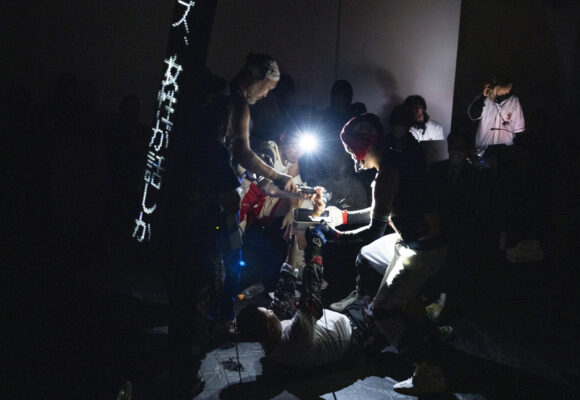Consultant and journalist Nobi Hayashi has been reporting on the latest in digital technology since 1990, covering the popularization of computers and the internet and how digitalization has altered the way we work and live. Having come to the realization that technology alone cannot bring about abundance, Hayashi’s reporting, writing, consulting, event planning, and business development work now crisscrosses disciplines including technology, design, art, fashion, and education, with a focus on the values that ought to be preserved into the 22nd century. He has written several books and is a visiting professor at the Kanazawa College of Art. Hayashi is an outside director at Revolver Inc and a member of the Good Design Award jury.
Emotional capitalism and human nature in the solo exhibitions of Michiko Tsuda and Saeborg
The Tokyo Contemporary Art Award (TCAA) 2022-2024 Exhibition is currently showing at the Museum of Contemporary Art Tokyo, where the work of Michiko Tsuda and Saeborg, the winners of the fourth edition of the award, can be viewed until July 7, 2024 as part of their respective solo exhibitions.
Awarded for the fourth time, the TCAA is a contemporary art prize that was established in 2018 by the Tokyo Metropolitan Government and Tokyo Arts and Space (TOKAS) to help mid-career artists make further strides. The program offers ¥3 million in prize money, backing for undertaking artistic activities overseas, and support for producing a bilingual monograph that can be used to promote the artist in both domestic and international contexts, as well as an opportunity to exhibit one’s work in a solo exhibition such as those reviewed here.
Past winners include Sachiko Kazama, Motoyuki Shitamichi, Hikaru Fujii, Chikako Yamashiro, Lieko Shiga, and Kota Takeuchi, and in January Tetsuya Umeda and Haji Oh were announced as the winners of TCAA 2024–2026, the fifth edition of the award.
This exhibition consists of two solo exhibitions presenting the work of the respective winners, Michiko Tsuda and Saeborg.
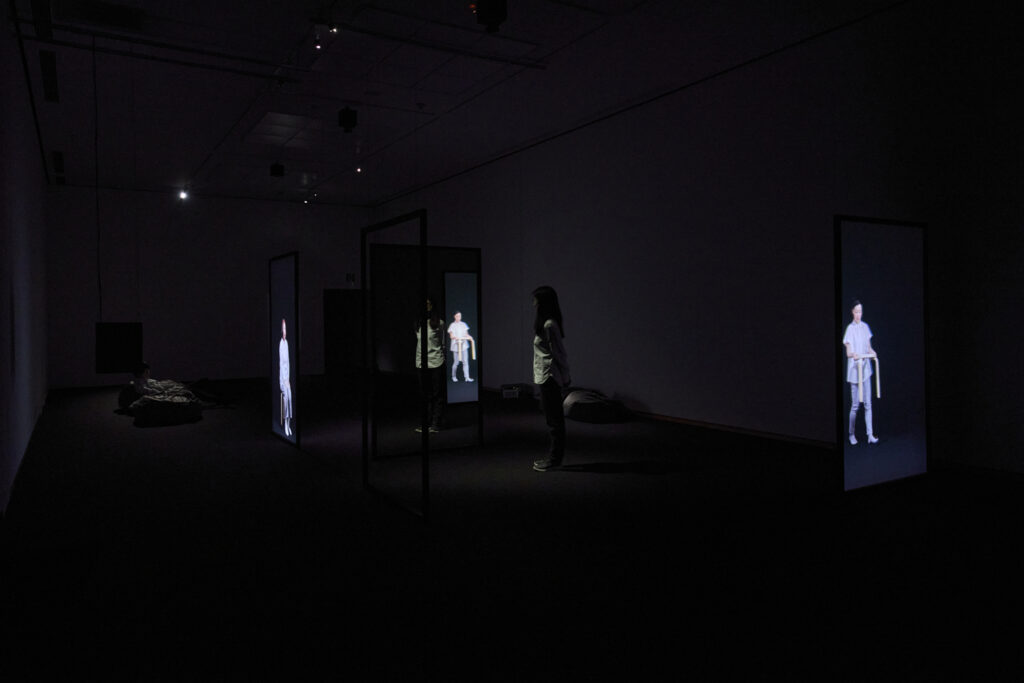
TSUDA Michiko, Life Condition, 2024, video, mirrors, wood, screens, sound Photo: TAKAHASHI Kenji Photo courtesy of Tokyo Arts and Space
Michiko Tsuda is an artist who utilizes video equipment and simple structure in her works to make visible aspects of human behavior. Her tendency to incorporate the viewer’s own body as a part of her works is one she shares with Saeborg.
This solo exhibition features four works, including the Yeu and Mo fmylia video piece from 2007. Precisely because many of her works deal with simplified, encoded human behavior, they are effective in evoking the biases and other personal, human qualities of the people depicted.
In Life Condition, a room is partitioned with eight frames, some of which are inlaid with screens or mirrors, while others are empty so that the viewer can see past them. This addition of a new, dynamic element—the viewer’s movement—to the act of viewing an installation, which tends to be a static activity, echoes You would come back there to see me again the following day., one of the artist’s best-known works. Here the frames are bigger, however, with full-length mirrors, evolved to allow near-life-size projections of the actors’ entire bodies. The footage in the work depicts several actors performing various everyday but deformed movements over and over. The codified movements bring out the actors’ personalities.
The actors in the film perform small everyday actions such as cooking, cleaning, and changing light bulbs. These acts are distorted and codified—for instance, instead of holding an actual broomstick, the palm of a hand is used to perform a sweeping function—but once you understand what’s going on, strangely enough, you find yourself becoming emotionally invested in the performers. Even more interestingly, even though the gestures are extremely simplified and symbolic, each performer’s personality shines through. The unconscious subtleties of the actors make us imagine what they’re like as people, all while reminding us that our own gender biases may be reflected in the personalities we envision.
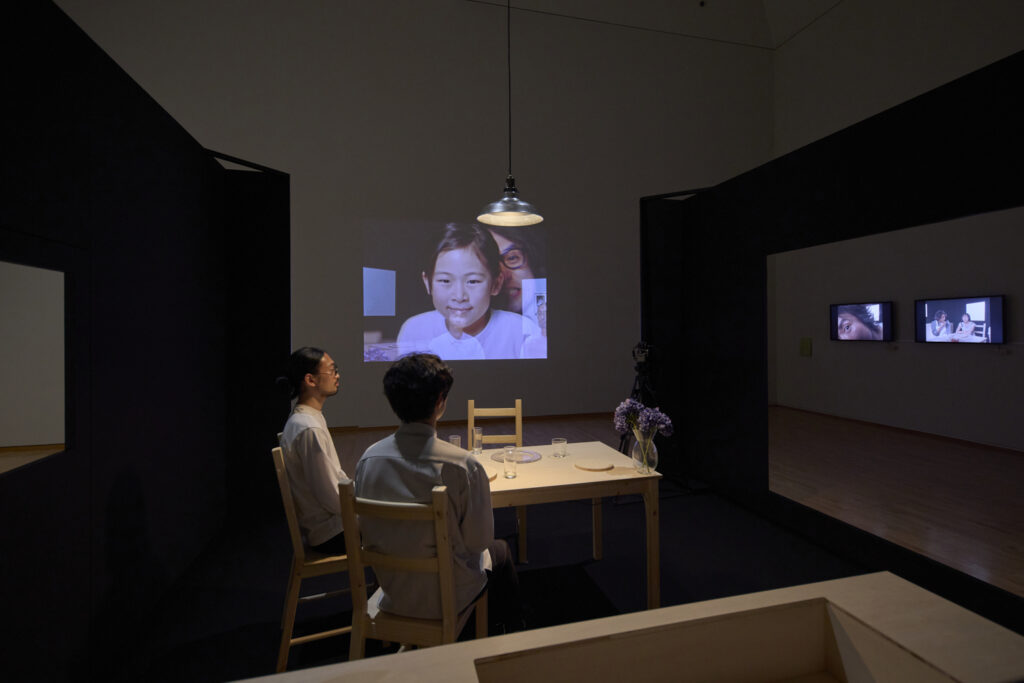
TSUDA Michiko, Hello, Camera, 2024, video, shooting set, camera, photos, cutting sheet Photo: TAKAHASHI Kenji Photo courtesy of Tokyo Arts and Space
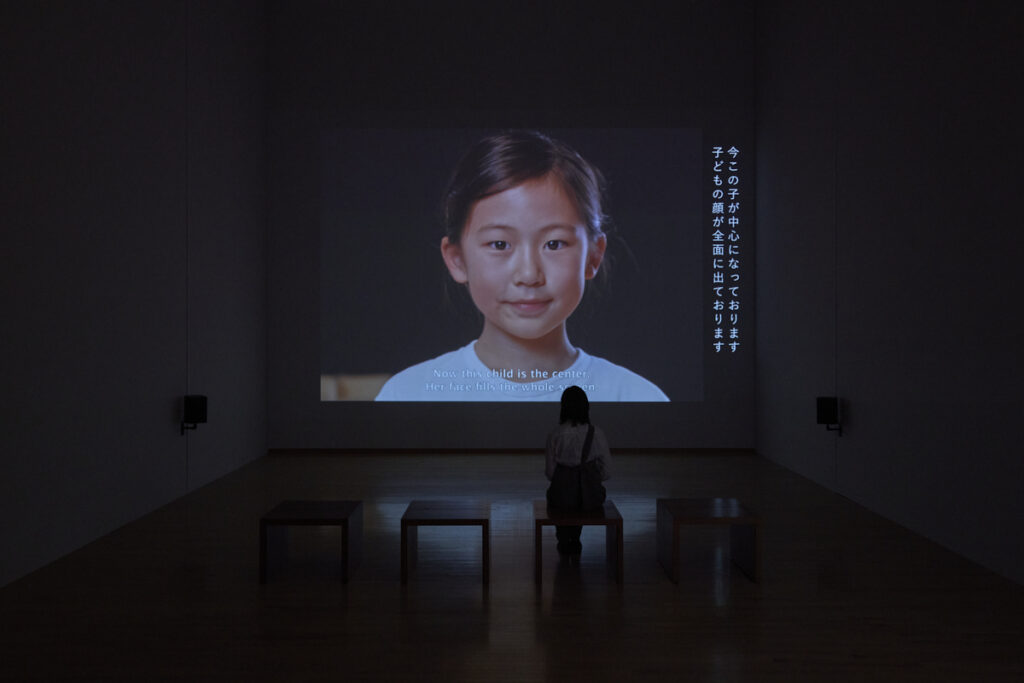
TSUDA Michiko, Hello, Camera, single channel version, 2024, video, 4min. Photo: TAKAHASHI Kenji Photo courtesy of Tokyo Arts and Space
Hello, Camera, the work that can be called the main exhibit of this show, is composed of footage projected onto a giant screen, different video clips playing on 11 monitors, a film set, 12 family photographs, and drawings on walls that illustrate the movement of people.
The work is based on footage shot in 1988, after the then eight-year-old Tsuda’s father bought the family’s first video camera. The seemingly trivial five-minute clip features the father and young Michiko herself, who didn’t have any brothers or sisters and had begun to think of the camera as a substitute sibling, having fun with the device while her mother looks on somewhat uncomfortably. Tsuda has turned this situation into a screenplay, which is here performed by 12 actors who differ in terms of gender, age, and language, with the actors popping in and out of the three roles without regard for the original characters’ age or gender. Adults play the child, men play women, and people conduct conversations in which one party speaks Korean and the other Japanese. Something feels off, but what? The work makes the viewer think about the biases that emerge when an actor adopts a gender or age different from their own. The actual set used to film these clips is displayed in the gallery—so that visitors might put themselves in the same position as the actors and see what feelings this elicits, rather than only pondering these things in the abstract. Meanwhile, diagrammatic representations of the actors’ movements in the room are displayed on the walls, providing a peek into the relationships between physical and psychological “movement.”
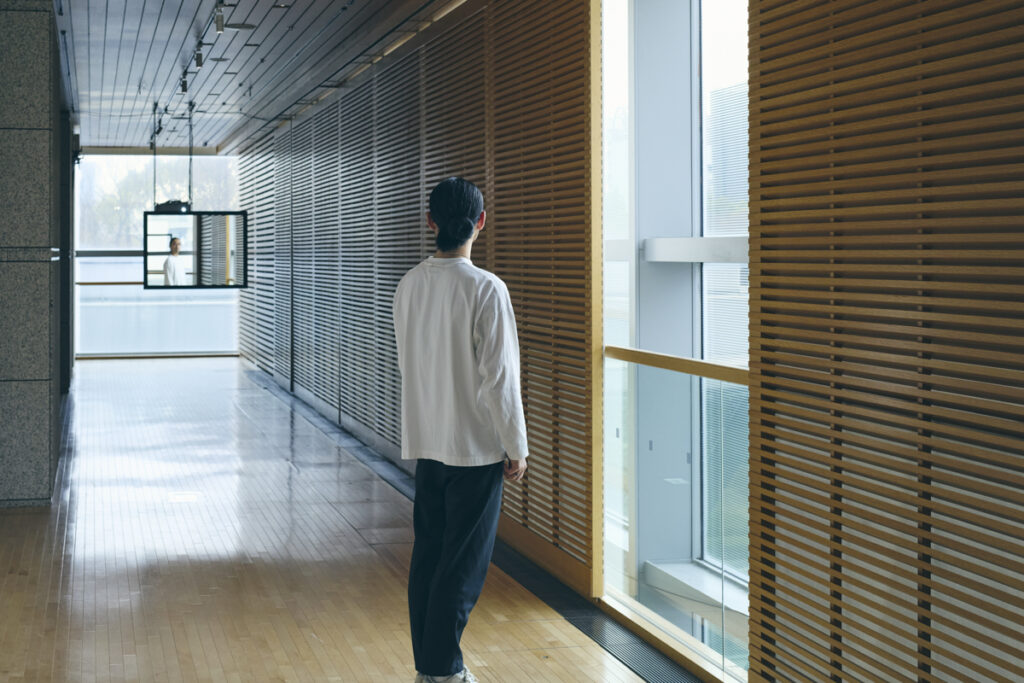
TSUDA Michiko, Looking Back, 2022/2024, mirrors, wood, software, camera Photo: TAKAHASHI Kenji Photo courtesy of Tokyo Arts and Space
Displayed in a corridor connecting two of the main works is Looking Back, a work comprising a camera and footage played on a slight delay, as if referencing the exhibition title. In this work, the camera captures people’s actions “in an unguarded state, like when merely passing by.” The visualization of unconscious behavior—something that is usually difficult to observe objectively—enables the viewer to conduct a personal confirmation of Tsuda’s intentions.
By centering bodies seen through the lens of a camera, “Life is Delaying” makes us rethink what makes a person unique, and what human individuality and human nature really are.
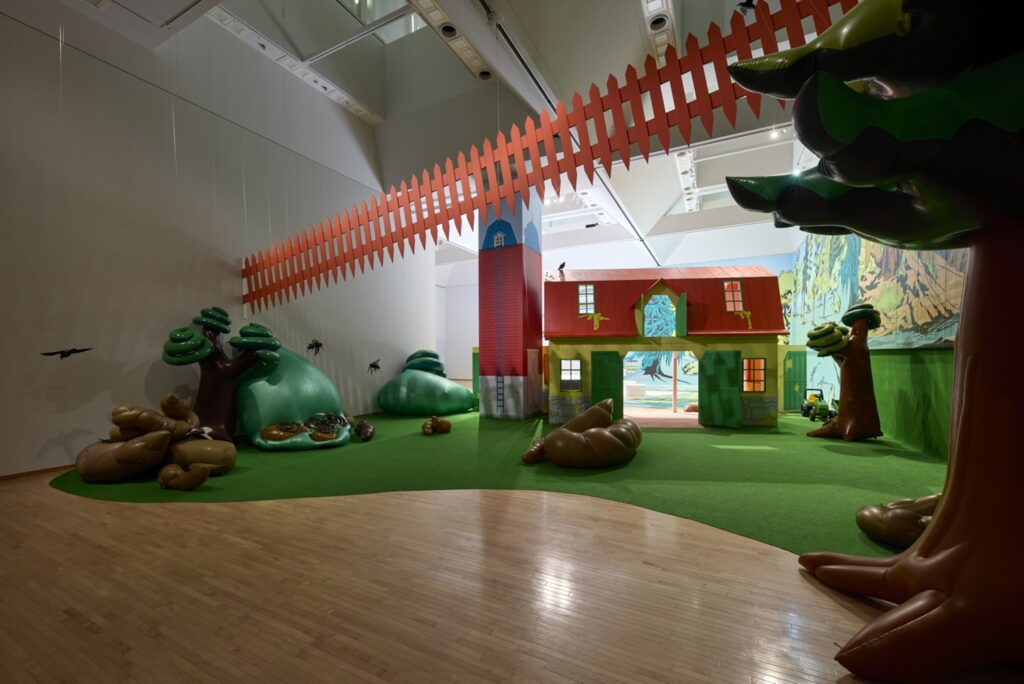
Saeborg, I WAS MADE FOR LOVING YOU, 2023-2024, installation Photo: TAKAHASHI Kenji Photo courtesy of Tokyo Arts and Space
The other solo exhibition taking place at the same time, Saeborg’s I WAS MADE FOR LOVING YOU is imbued with a completely different atmosphere.
Stepping into the gallery, the colorful and joyous space made me feel like I’d entered a human-sized dollhouse; a place any child would presumably love to run around. At the far end of a farm adorned with towering trees made out of latex stands a house just like one a loving family would live in, like something straight out of little house on the prairie.
Beyond its door is a shining stage, and on the stage stands a cute latex dog that looks like it just popped out of a comic book. When I approach it, the teary-eyed dog comes toward me. When I pet the attention-craving creature on its head and nose, it returns teasing glances and presses in for more.
All of a sudden, I notice the gaze of other visitors—and that their phone cameras are all pointing at me. Unknowingly, I’ve transformed from spectator to performer. Embarrassed, I try to walk away, but the crying dog keeps looking at me, making me feel a painful reluctance followed by a flash of guilt.
Taking another look at the dog’s body suit, I notice bald spots on parts of the head and shoulders, perhaps caused by emotional stress. There are also scars on its tongue; one might think it looks ill. Looking beyond the dog, in the background is a vast prairie painted on one of the massive walls of the high-ceilinged gallery, but the picture breaks off in the middle of the scenery, followed by nothing but a solid white wall. It’s like arriving at the end of a virtual space (metaverse), the place after which no more data is available, or like waking up from a dream. Perhaps what initially seemed like a utopia is actually a dystopia, or a nightmare. Rushing out of the house, I find that the idyllic-looking pasture around it is in face replete with latex livestock droppings, with latex flies swarming all over them.
Looking back at the silhouette of the looming house, it now seems like a wall covering up an inappropriate relationship between people and their pets.
However, if you don’t read too much into it, rest assured that this exhibition can be taken as just a charming display that children can enjoy. I saw many students happily enjoying the cuteness and taking photos.
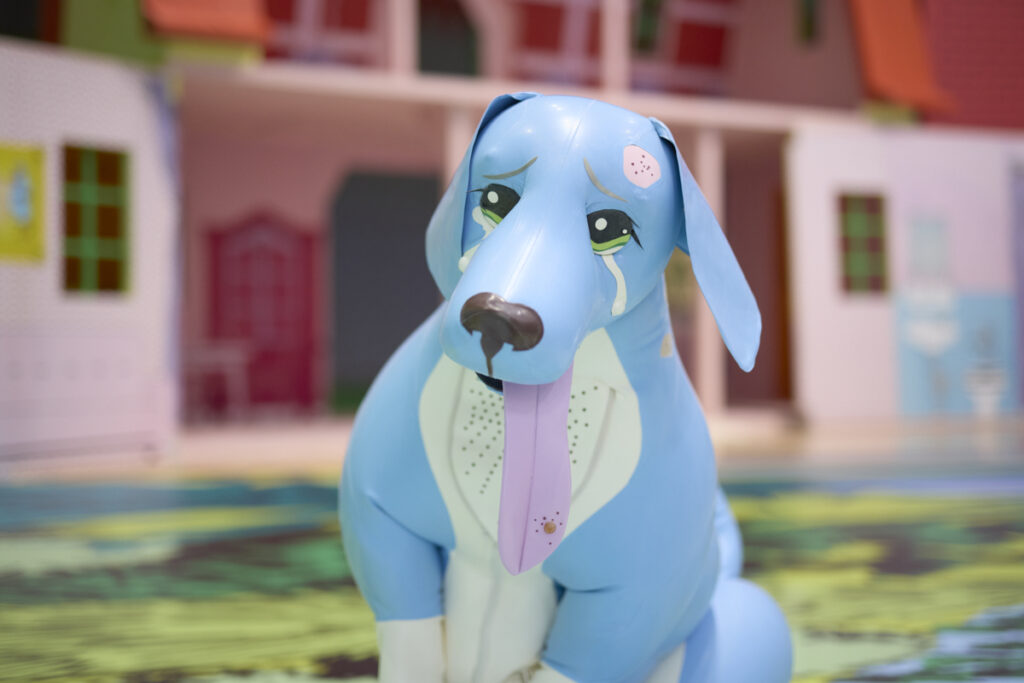
Saeborg, I WAS MADE FOR LOVING YOU, 2023-2024, installation Photo: TAKAHASHI Kenji Photo courtesy of Tokyo Arts and Space
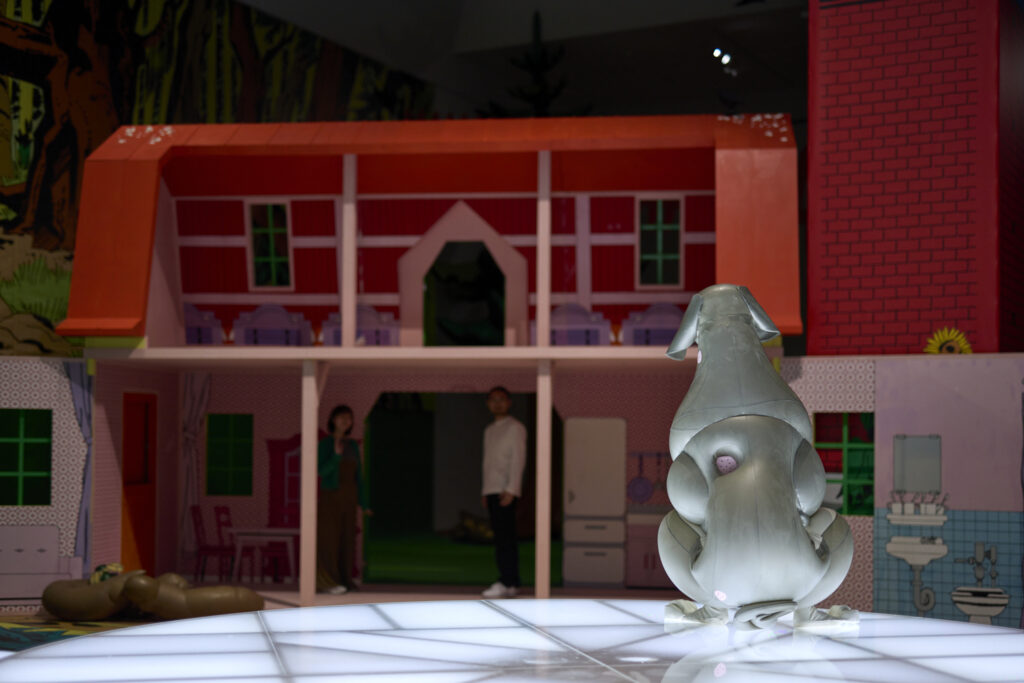
Saeborg, I WAS MADE FOR LOVING YOU, 2023-2024, installation Photo: TAKAHASHI Kenji Photo courtesy of Tokyo Arts and Space
Saeborg is an artist noted for performances and installations that involve self-made latex animals (body suits), which she has presented both in Japan and abroad. Half human, half toy, these imperfect, artificial cyborgs transcend categories such as gender and age. The deformed and colorful latex livestock and pests in her works challenge viewers to consider the dilemma of coexistence by raising issues such as human cruelty, problems related to consumption, and difficulties in the fields of care and nursing.
Her newest creation is based on the recent works House of L and Super Farm, but while these dealt with livestock such as pigs and sheep, I WAS MADE FOR LOVING YOU focuses on pets. Featuring “Saedog,” a performer clad in a canine latex bodysuit, the work brings into focus questions such as what weakness and power really are.
According to the artist herself, “Central to this new work are organisms such as pets, seemingly purposeless entities that defy the usual survival-of-the-fittest logic of evolutionary competition, securing their places in the ecosystem by embodying human emotions and fantasies (in a sense, surviving purely through the power of love). With this modest endeavor, my aim is to push the envelope and explore this enigmatic power to the fullest.”
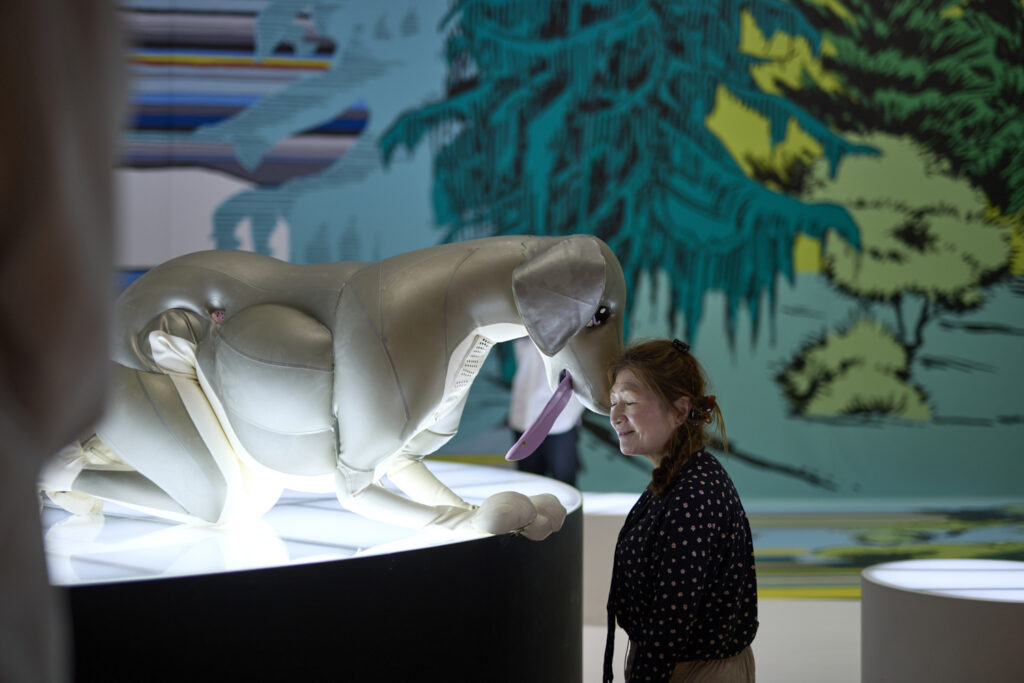
Saeborg, I WAS MADE FOR LOVING YOU, 2023-2024, installation Photo: TAKAHASHI Kenji Photo courtesy of Tokyo Arts and Space
One of the Japanese words for pet, aigan dobutsu, carries the connotation that such an animal is both an object of affection and a source of comfort for its owner. In other words, pets are weak beings that are kept alive to provide a distraction for humans. But this is a weakness that goes both ways; we humans have an inherent vulnerability that drives us to depend on such animals to escape loneliness and other anxieties.
However, what seems like a mutually advantageous relationship is disrupted by the economic principles of human existence. Under an economic system in which compensation is earned through increasing value, humans strive to produce emotional products with ever higher commodity value by breeding and exchanging easily lovable, “weak-looking” pets. At a symposium held prior to the exhibition, Saeborg described this as “emotional capitalism.” Relatedly, humans have in recent years started developing robotic pets that make away with issues of bereavement, care, and other hassles associated with life.
Ideals and reality, the cute and the grotesque, utopia and dystopia, and aspects of cuteness and cunning that derive from weakness converge in this latex metaverse of an artwork, providing another opportunity to think about “de-anthropocentrism,” an idea that came to the fore in the wake of the Covid-19 pandemic.
These two solo exhibitions by two artists, Saeborg and Michiko Tsuda, inspire us to reconsider, through our own bodies, the distortions of human society and the nature of human beings in an age when societies are undergoing dramatic change with the emergence of technologies such as artificial intelligence.
Translated by Ilmari Saarinen
INFORMATION
TSUDA Michiko “Life is Delaying” / Saeborg “I WAS MADE FOR LOVING YOU”
Tokyo Contemporary Art Award 2022-2024 Exhibition
Period: March 30 to July 7, 2024
Venue: Museum of Contemporary Art Tokyo, Exhibition Gallery 3F
Open hours: 10 a.m. to 6 p.m.
Closed: Mondays
Admission: Free
Organizers: Tokyo Metropolitan Government, Tokyo Arts and Space / Museum of Contemporary Art Tokyo of the Tokyo Metropolitan Foundation for History and Culture
Cooperation: TARO NASU


